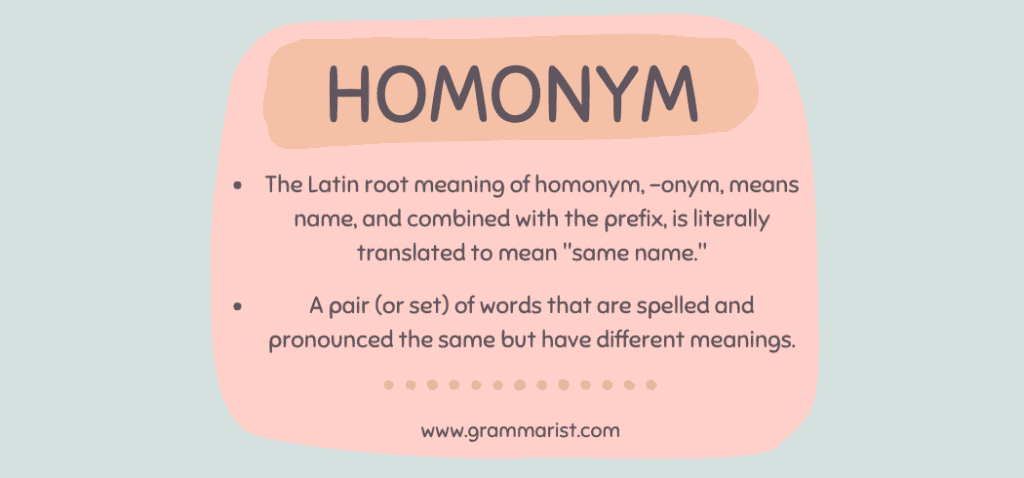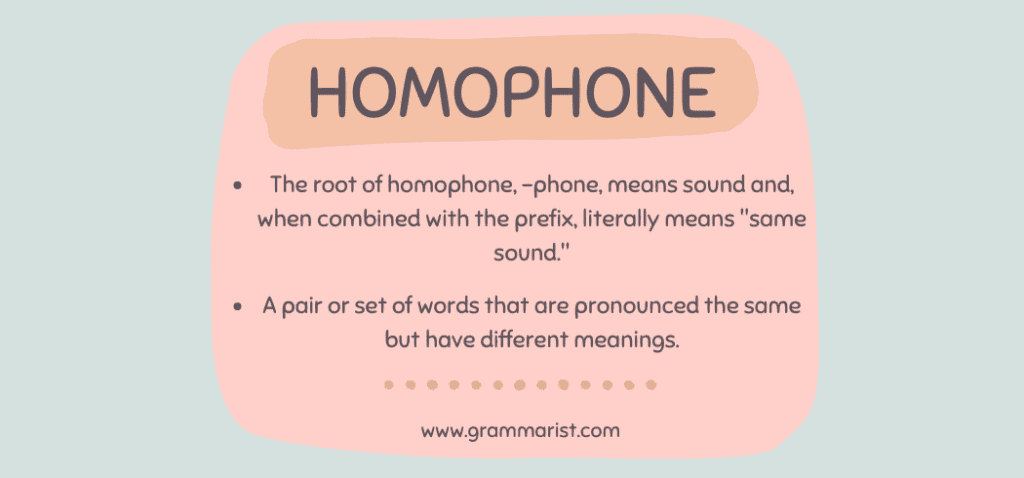The English language is full of words that either sound the same, are spelled the same, or both – but mean different things. These are called homophones, homonyms, and homographs, and their prefix, homo-, means same in Latin.
And it’s no wonder they often confuse native speakers and English learners.
Learning to discern these words from one another is important for written communication, and we offer definitions and examples of their differences below.
What is the Difference Between Homophones, Homonyms, and Homographs?
Before we delve too deep into the differences between these words, there are some grammatical disagreements surrounding their definitions, depending on who you may ask. There is a misconstrued and incorrect belief that homophones and homographs are both a subcategory of homonyms, but this isn’t (entirely) true.
Take a look at the definitions of each and how they are used below.
What are Homonyms?

The Latin root meaning of homonym, -onym, means name, and combined with the prefix, is literally translated to mean “same name.” Knowing your root words is a way to help remember which word means what since homonym, homophone, and homograph all sound so similar and deal with similar word details.
A homonym is a pair (or set) of words that are spelled and pronounced the same but have different meanings.
- For example, the work light describes an object that casts illumination, as in the sentence, “please go turn the living room light on before we leave.”
- Light can also be an adjective meaning to describe the brightness of a color hue or the illumination of a room. For example, “I believe I will go with the lighter version of blue to paint the trim with.”
- Light can also mean the opposite of heavy, as in the sentence, “She was very light, so carrying her through the park was no burden.”
- You can also use the verb meaning of light to describe the action of “lighting a candle” or “lighting the fire.”
Examples of Homonyms in Sentences
It was an unusually late spring, and many fruit trees were late to harvest because of it.
Vs.
The spring under the bike seat helped alleviate the rough terrain they were riding over.
The rough seas caused the boat to tilt and founder in shallow waters.
Vs.
The founder of the company sold his shares to his family to protect the integrity of his investment.
Our new puppy has a shrill, annoying bark.
Vs.
The beech tree has a smooth, gray bark.
What is a Homophone?

The root of homophone, -phone, means sound and, when combined with the prefix, literally means “same sound.” Homophones are a pair or set of words that are pronounced the same but have different meanings. They can have the exact spelling, but this is not required.
When a set of homophones are spelled that same, they can also be categorized as a homonym, although the same spelling is not required. An example of this is the example of the word light explained above.
Another example is see and sea. See is a verb and is the word to describe a physical sense. An example is, “I can see the route we need to take on the map” or “I see the hard work you are putting in on this job.”
Sea is a noun form to describe a large body of ocean. For example, “He launched his boat on the sea.”
Examples of Homophones in Sentences
The windowless classroom felt a bit like a jail cell to the students.
Vs.
He had to sell approximately 50 items for the band camp fundraiser.
Her favorite garden flower was the rose.
Vs.
The rows in the auditorium were well planned so all guests could hear the performances clearly.
The children waved bye as they drove away.
Vs.
She returned to the store to buy the shoes she had been coveting.
Vs.
A flock of birds flew by while she waited on the park bench.
What is a Homograph?

The root of homograph, -graph, means write and when combined with the prefix, means “to write the same.” Homographs are pairs of words with the same spelling but are pronounced very differently.
For example, bow vs. bow. Bow (rhymes with so) is a type of weapon used in archery. Bow (rhymes with cow) is part of a ship or boat.
A homograph pair cannot be a homonym since the words do not sound the same, despite some people’s arguments about this fact.
The confusion surrounding this stems from the Oxford English Dictionary, which states a homograph has the same spelling but also must be of a “different origin.” Other dictionaries state they must be spelled the same but pronounced differently.
People have assumed that words of a different root word origin can still be pronounced the same, which is technically accurate, but to do so would then define it as a homophone or homonym, not a homograph. This is a common interpretative mistake.
Examples of Homographs in Sentences
Bass, dove, object
He was trying to master the bass (rhymes with ace) guitar for his band’s performance.
Vs.
They rose early in the morning to go bass (rhymes with class) fishing off the docks.
She dove (rhymes with cove) into the pool to show off her swimming skills.
Vs.
There is a dove (rhymes with love) nest in the arbor that has three baby birds in it.
The object (rhymes with project) of a sentence is the person or thing that receives the verb’s action.
Vs.
To take exception to something is to object (rhymes with deject) to it.
Homonym, Homophone, Homograph Quick Review
- Homonym: sets of words spelled the same and sound the same but have different meanings.
- Homophone: sets of words that are pronounced the same but have different spelling and meanings. They may also be spelled the same, also making them a homonym.
- Homograph: pairs of words that are spelled the same but pronounced differently and have different meanings.
